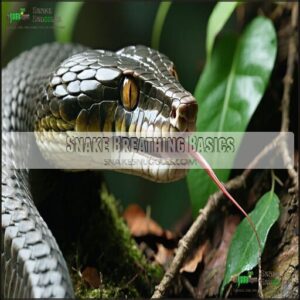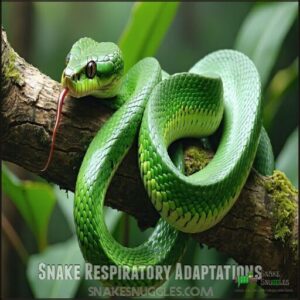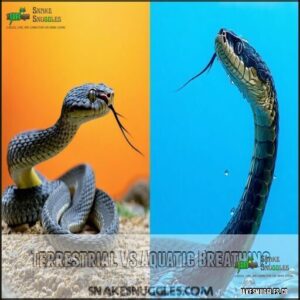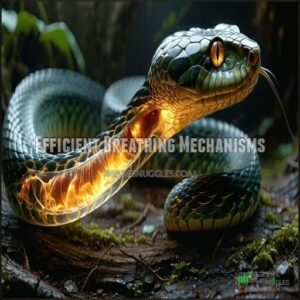This site is supported by our readers. We may earn a commission, at no cost to you, if you purchase through links.
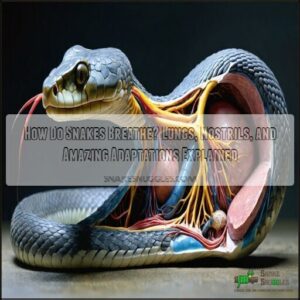 Snakes breathe using their lungs, with most species relying on one large lung for oxygen exchange.
Snakes breathe using their lungs, with most species relying on one large lung for oxygen exchange.
They don’t have a diaphragm like you do, so they use their ribs and muscles to expand and contract their body, pulling air in and out.
Their glottis, a small opening near the front of their mouth, helps them breathe even while swallowing prey—talk about multitasking!
Some aquatic snakes can absorb oxygen through their skin underwater, adding a clever twist to their breathing game.
With specialized nostrils and a flexible windpipe, snakes have mastered efficient breathing, whether they’re on land or underwater. Curious yet?
Table Of Contents
- Key Takeaways
- Snake Breathing Basics
- How Snakes Breathe
- Snake Respiratory Adaptations
- Breathing in Different Environments
- Efficient Breathing Mechanisms
- Modular Lung Ventilation
- Selective Rib Movement and Oxygen Absorption
- Energy Efficiency in Snake Breathing
- Do snakes have lungs or gills?
- How do snakes not suffocate when eating?
- Do snakes breathe through nostrils?
- How long can snakes hold their breath?
- How do snakes breathe?
- Do snakes have a respiratory system?
- Do snakes need a diaphragm to breathe?
- Can snakes breathe if lungs are obstructed?
- What does snake breathing look like?
- Do snakes breathe from their skin?
- Conclusion
Key Takeaways
- Snakes breathe using their lungs, with most relying on one large lung and rib muscles to pull air in and out.
- Their glottis acts like a snorkel, letting them breathe even while swallowing prey.
- Some aquatic snakes absorb oxygen through their skin underwater, adding a survival edge.
- Specialized nostrils and a flexible windpipe help snakes breathe efficiently on land and in water.
Snake Breathing Basics
Snakes rely on their lungs to breathe, just like you rely on your nose and mouth. Unlike fish, they don’t have gills, so air is essential for their survival.
Lungs as Primary Respiratory Organ
Ever wonder how snake lungs handle breathing so efficiently? Their respiratory system is uniquely adapted for survival, with lung structure allowing for maximum oxygen intake.
Here’s what makes snake lungs special:
- They rely on a single large lung for gas exchange.
- Some species have a second, smaller lung.
- Breathing efficiency varies by respiratory rate.
- Adaptations support precise lung function in snake anatomy.
Absence of Gills in Snakes
Snakes don’t have gills, a feature lost during their evolutionary history.
Instead, they rely on their lungs and air sacs for oxygen intake. This Gill Loss, rooted in embryonic development and shaped by the genetic basis for terrestrial life, highlights adaptive significance.
Unlike fish, underwater breathing isn’t possible for snakes, making their need to surface a critical survival behavior.
Importance of Air for Survival
Your body depends on air, and snakes are no different!
Oxygen’s role in their survival hinges on fueling energy production through cellular respiration.
Their snake respiratory system, including lungs and air sacs, guarantees oxygen reaches cells for metabolism.
Without air, their survival dependence falters.
- Oxygen drives energy in cells.
- Gas exchange supports metabolic needs.
- Air sustains the snake breathing process.
- Cellular respiration keeps snakes active.
How Snakes Breathe
Snakes have a fascinating respiratory system that’s simple yet incredibly efficient.
Snakes breathe with precision and efficiency, using their unique anatomy to master oxygen intake in any environment.
They rely on their lungs for air intake, which is essential for maintaining oxygen levels and staying alive. But how do snakes breathe? It’s all about precise techniques and specialized anatomy.
Here’s how it works:
- Snake lungs: Most have one functional lung (right), optimized for gas exchange.
- Airflow control: Their glottis, a small opening, regulates air intake during breathing.
- Flexible windpipe: Positioned near the front of their mouth, it helps breathe while swallowing.
- Muscle-driven breathing: Rib muscles expand and contract their body for airflow.
- Oxygen distribution: Oxygen smoothly travels through the bloodstream for energy.
The unique lung ventilation system allows snakes to efficiently breathe in various environments.
Who knew reptile respiration could be this cool?
Snake Respiratory Adaptations
Snakes have incredible respiratory adaptations that let them breathe in a variety of environments, from dry deserts to underwater habitats.
With features like specialized nostrils and even the ability to absorb oxygen through their skin, they’ve mastered the art of survival.
Specialized Nostrils and Valves
A snake’s nostrils come with nifty valves, creating a clever adaptation for controlling airflow.
These nostril valves seal tight during dives, keeping water out of the nasal passage.
This aquatic adaptation is key, especially for sea snakes, ensuring respiratory control even underwater, and the valve mechanism showcases how the reptile respiratory system evolves, proving snake nostrils are more advanced than they appear!
Windpipe and Breathing Mechanism
The windpipe in snakes, or trachea, is a marvel of design.
The glottis, a valve-like structure, lets snakes control airflow even while eating. When their mouth is full, they extend the windpipe forward like a snorkel!
This smart adaptation guarantees oxygen intake remains uninterrupted.
Snake breathing mechanisms show how their anatomy balances survival and efficiency perfectly.
The unique lung ventilation system allows snakes to breathe efficiently in various environments.
Cutaneous Respiration in Aquatic Snakes
Imagine breathing through your skin—it’s a lifesaver for aquatic snakes.
Thanks to cutaneous respiration, water snakes supplement oxygen intake underwater.
This aquatic adaptation allows oxygen exchange directly through their vascularized skin, particularly around their heads.
While their lungs handle buoyancy control and primary breathing, cutaneous exchange guarantees survival during dives.
It’s nature’s clever trick for efficient snake respiratory systems.
The unique snake breathing mechanism is vital for their survival in various environments, making aquatic adaptation a key factor.
Breathing in Different Environments
Snakes breathe differently depending on whether they’re on land or in water, using amazing adaptations to survive.
While some rely on nostrils and lungs, others can even absorb oxygen through their skin when underwater.
Terrestrial Vs Aquatic Breathing
Land snakes breathe air through nostril valves, relying on lung adaptations for efficient oxygen intake.
Water snakes, like sea snakes, face a challenge—Water vs. Air isn’t optional. They surface for breath-holding, though some aquatic snakes use skin respiration as backup oxygen intake.
In both cases, survival means balancing environments where lungs shine and water can’t flood their systems. Snakes also utilize modular lung ventilation to efficiently manage their breathing in various environments, ensuring their survival in different conditions with efficient oxygen intake.
Adaptations for Underwater Breathing
Sea snakes have fascinating breathing adaptations for life underwater.
Their nostril valves prevent water entry, while extended lungs store air for dives, aiding buoyancy control. Glottis closure keeps the snake’s respiratory system dry.
They even use cutaneous respiration, absorbing oxygen through their skin. These adaptations answer the question, "How do snakes breathe underwater?"—specialized tools guarantee survival in their submerged world.
The unique snake breathing mechanism involves a modular lung system that allows for efficient gas exchange, which is crucial for their underwater life, making them a remarkable example of evolutionary adaptation.
Role of Skin in Oxygen Absorption
Aquatic snakes really show off in the area of breathing tricks! Their skin respiration, also known as cutaneous exchange, enables oxygen diffusion through their epidermis.
Here’s the breakdown:
- Dermal absorption occurs mainly on the head.
- Epidermal gas exchange supports lung breathing underwater.
- Species with cutaneous respiration adaptations excel in low-oxygen conditions.
So, do snakes breathe through skin? Some actually do, which is a remarkable example of skin respiration.
Efficient Breathing Mechanisms
Snakes use clever breathing tricks to stay efficient, like moving their ribs to control airflow.
Their lungs are designed to save energy while delivering just the right amount of oxygen, even when they’re on the move, using clever breathing tricks.
Modular Lung Ventilation
Snakes use modular lung ventilation to keep their respiratory systems efficient.
Their lung modules allow unidirectional flow, making gas exchange smoother. The sacular lung acts like a reserve tank, aiding snake respiration systems during movement or when other muscles are in use.
This unique positive pressure breathing helps maintain respiratory efficiency, ensuring their snake lungs and gas exchange adapt perfectly to their needs.
Proper air quality management is also essential for maintaining healthy snakes.
Selective Rib Movement and Oxygen Absorption
Snakes are masters of efficiency in breathing, thanks to rib movement. Each rib expands and contracts, driving oxygen intake while supporting buoyancy control.
Unlike us, their snake ventilation system relies on precise respiratory mechanics of reptiles, allowing their long, narrow lung to maximize efficiency.
Bonus? Some species even absorb oxygen through cutaneous exchange, enhancing the snake respiration system further. Fascinating, right? The unique snake rib movement plays a pivotal role in this process.
Energy Efficiency in Snake Breathing
Snakes are masters of energy conservation, thanks to their efficient breathing mechanisms.
Their snake respiratory system optimizes oxygen use while keeping the metabolic cost low.
Here’s how:
- Selective rib movement minimizes muscular effort.
- Lung ventilation adjusts airflow based on activity.
- Respiratory adaptations like long lungs store oxygen efficiently.
It’s like a well-tuned engine, running smoothly without wasting fuel!## Frequently Asked Questions
Do snakes have lungs or gills?
Snakes have lungs, not gills.
They rely on their lungs for breathing air, just like you do. Gills are for fish, not reptiles!
Some aquatic snakes even absorb oxygen through their skin for extra help, which is a unique feature that aids their survival.
How do snakes not suffocate when eating?
Imagine eating a sandwich while breathing through a straw—snakes do something similar.
They extend their windpipe, which acts like a snorkel, allowing them to pull in air even when their mouth is full of prey.
Do snakes breathe through nostrils?
Yes, snakes breathe through nostrils, but it’s not their only trick.
They can also breathe through their mouths, especially while eating.
Some species even have adaptations that allow limited oxygen absorption through their skin!
How long can snakes hold their breath?
Some snakes can hold their breath for over an hour.
Sea snakes, for example, store oxygen in their long lungs.
Still, they eventually surface, proving even nature’s best free divers have their limits!
How do snakes breathe?
You’ll find that snakes rely on lungs to breathe, pulling air through internal structures.
Some species even absorb oxygen through their skin underwater.
Their specialized adaptations guarantee survival in diverse environments, from deserts to oceans.
Do snakes have a respiratory system?
It’s not rocket science—snakes have a respiratory system like other vertebrates.
They rely on lungs for breathing, with some species sporting one functional lung.
Unique adaptations help them thrive in diverse habitats, including aquatic environments, with diverse habitats being a key factor.
Do snakes need a diaphragm to breathe?
A diaphragm isn’t required for a snake to breathe.
Instead, muscles along its ribs handle the job.
It’s like doing a full-body workout just to inhale—efficient but definitely not your average human method!
Can snakes breathe if lungs are obstructed?
If a snake’s lungs are obstructed, it can’t breathe properly, which is life-threatening.
Unlike mammals, they lack a diaphragm to assist breathing, so their muscles and unobstructed lung are essential for survival.
What does snake breathing look like?
Imagine a subtle dance—snakes breathe by expanding their ribcage, pulling air into their lungs.
You’ll notice rhythmic body movements, especially near their midsection, as they inhale oxygen through internal nostrils or specialized openings.
Fascinating, right? This is indeed a fascinating aspect of snake biology.
Do snakes breathe from their skin?
While most snakes rely on lungs, some aquatic species, like sea snakes, can absorb small amounts of oxygen through their skin.
It’s a backup system, not their main way of breathing.
Conclusion
Did you know snakes can hold their breath for up to an hour?
It’s all thanks to their efficient breathing system. Using one main lung, their ribs and muscles pull air in and out, while their glottis keeps airflow steady—even when swallowing prey.
Aquatic snakes take it further, absorbing oxygen through their skin underwater. These adaptations let snakes thrive in diverse environments.
So, how do snakes breathe? With fascinating efficiency and clever evolutionary tricks!
- https://www.quora.com/How-do-snakes-breathe
- https://byjus.com/question-answer/snakes-breathe-through-9/
- https://www.facebook.com/HerpSmitten/videos/snakes-can-breathe-via-their-nostrils-or-glottis-a-small-opening-located-just-be/1442058459577906/
- https://www.scientificamerican.com/article/how-snakes-breathe-while-crushing-prey/
- https://a-z-animals.com/blog/how-do-sea-snakes-breathe/

